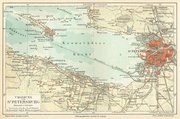Kronstadt
|
|
- This article is about the Russian town known in English as Kronstadt. Kronstadt is also the historical German name for the city of Braşov, Romania.
Kronstadt (Russian: Кронштадт; also Kronshtadt, Cronstadt) is a strongly fortified Russian seaport town, located on Kotlin Island, near the head of the Gulf of Finland, at Template:Coor dms. It lies 20 miles west of Saint Petersburg, of which it is the chief port. It was the site of the Kronstadt rebellion of March 1921.
Traditionally, it has served as the base of the Russian Baltic Fleet and the seat of the Russian admiralty, and to guard the approaches to the city of Saint Petersburg.
History
Cathedral_kronstadt.jpg
Kronstadt was founded in 1710 by Peter the Great, who took the island of Kotlin from the Swedes in 1703, when the first fortifications were constructed.
Kronstadt was thoroughly refortified in the 19th century. The old three-decker forts, five in number, which formerly constituted the principal defences of the place, and defied the Anglo-French fleets during the Crimean War, became of secondary importance. From the plans of Eduard Totleben a new fort, Constantine, and four batteries were constructed (1856-1871) to defend the principal approach, and seven batteries to cover the shallower northern channel. All these fortifications were low and thickly armoured earthworks, powerfully armed with heavy Krupp guns in turrets. The town itself is surrounded with an enceinte.
In the year 1921, a number of anarchist sailors and soldiers rebelled against the Bolshevik regime in Soviet Kronstadt. Their demands (http://www-personal.umich.edu/~mhuey/KRN/KRN.2.Beginning.html/) included freedom of speech, a stop to the deportation to concentration camps, a change of the Soviet war politics, and the right to have more private property. Leon Trotsky, then the leader of the Red Army, answered by sending the army to Kronstadt, and the uprising was ruthlessly suppressed. This was the last major revolt against Leninist or Stalinist rule within Russia until the fall of the Berlin Wall. During World War II, Kronstadt was bombed several times by German air force, the Luftwaffe. The most famous bombing must the the one in which the Soviet battleship Marat was sunk by Stuka ace Hans-Ulrich Rudel .
Features
The town of Kronstadt is built on level ground, and is thus exposed to inundations, from one of which it suffered in 1824.
Kronstadt_cathedral.jpg
On the south side of the town there are three harbours the large western or merchant harbour, the western flank of which is formed by a great mole joining the fortifications which traverse the breadth of the island on this side; the middle harbour, used chiefly for fitting out and repairing vessels; and the eastern or war harbour for vessels of the Russian navy. The Peter and Catherine canals, communicating with the merchant and middle harbours, traverse the town. Between them stood the old Italian palace of Prince Menshikov, the site of which was later occupied by a pilot school.
The modern town's most striking landmark is the enormous Naval Cathedral, built from 1908 to 1913 and considered to represent a culmination of the Russian Neo-Byzantism. The older St Andrew Cathedral (1817), formerly Kronstadt's pride and beauty, was barbarously destroyed by the Bolsheviks in 1932. St Ioann of Kronstadt, one of the most venerated Russian saints, served there as a priest from 1855 to 1908.
Among other public buildings are the naval hospital, the British seamans hospital (established in 1867), the civic hospital, admiralty (founded 1785), arsenal, dockyards and foundries, school of marine engineering, and the English church. The port is ice-bound for 140 to 160 days in the year, from the beginning of December till April. A very large proportion of the inhabitants are sailors.
Demographics
Historical population:
- 1867: 45,115
- 1897: 59,539
- 2001: 44,727da:Kronstadt (Rusland)
de:Kronstadt (Russland) fi:Kronstadt fr:Kronstadt ja:クロンシュタット pl:Kronsztad ru:Кронштадт sv:Kronstadt

